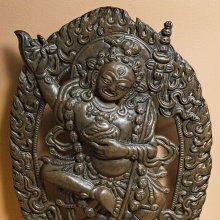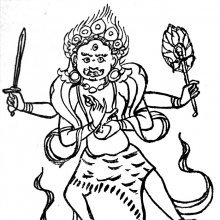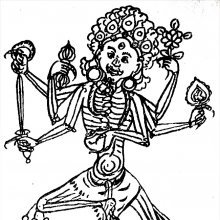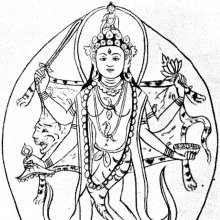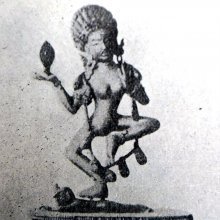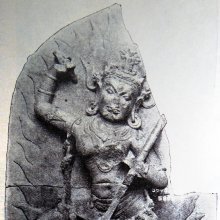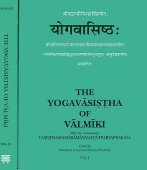Corpse: 1 definition
Introduction:
Corpse means something in Hinduism, Sanskrit. If you want to know the exact meaning, history, etymology or English translation of this term then check out the descriptions on this page. Add your comment or reference to a book if you want to contribute to this summary article.
Images (photo gallery)
(+15 more images available)
In Hinduism
Yoga (school of philosophy)
Source: ORA: Amanaska (king of all yogas): A Critical Edition and Annotated Translation by Jason BirchCorpse (meditation) forms part of the various Teachings or Techniques (saṅketa) on Layayoga, according to the Dattātreyayogaśāstra verse 21-26.—Note: The Dattātreyayogaśāstra’s techniques (saṅketa) of Layayoga can be summarised as meditation on the void, gazing on the tip of the nose, meditating on the back of the head, gazing between the eyebrows, meditating on the forehead and brow, meditating on the two big toes and lying on the ground like a corpse.

Yoga is originally considered a branch of Hindu philosophy (astika), but both ancient and modern Yoga combine the physical, mental and spiritual. Yoga teaches various physical techniques also known as āsanas (postures), used for various purposes (eg., meditation, contemplation, relaxation).
See also (Relevant definitions)
Starts with: Corpse plant.
Full-text (+624): Kunapa, Shava, Kaunapa, Pancavastha, Mukhagni, Shmashana, Shavodvaha, Mudada, Mritadeha, Mritadharaka, Purushakunapa, Mritadhara, Kshitivarddhana, Shavakamya, Pretanara, Preta, Mritanga, Samskarana, Vyadhmataka, Sahamarana.
Relevant text
Search found 194 books and stories containing Corpse; (plurals include: Corpses). You can also click to the full overview containing English textual excerpts. Below are direct links for the most relevant articles:
Mahabharata (English) (by Kisari Mohan Ganguli)
Section XLI < [Goharana Parva]
Section XLVIII < [Abhimanyu-badha Parva]
Section XLVIII < [Anusasanika Parva]
Maha Prajnaparamita Sastra (by Gelongma Karma Migme Chödrön)
II. The ten Asubhasaññā in the pāli Abhidhamma < [Preliminary note on the nine horrible notions (navāśubhasaṃjñā)]
II. How to meditate on the nine notions (navasaṃjñā) < [Part 1 - The nine notions according to the Abhidharma]
Kathasaritsagara (the Ocean of Story) (by Somadeva)
Note on vile magical practices < [Notes]
Notes on vampires < [Notes]
Chapter XCII < [Book XII - Śaśāṅkavatī]
Visuddhimagga (the pah of purification) (by Ñāṇamoli Bhikkhu)
General Definitions < [Chapter VI - Foulness as a Meditation Subject (Asubha-kammaṭṭhāna-niddesa)]
The Bloated, Livid, Festering, and Cut Up < [Chapter VI - Foulness as a Meditation Subject (Asubha-kammaṭṭhāna-niddesa)]
The Gnawed, Scattered, etc. < [Chapter VI - Foulness as a Meditation Subject (Asubha-kammaṭṭhāna-niddesa)]
Saying 60 - A Parable Of A Samaritan And A Lamb
Saying 56 - The World Is A Corpse
Charaka Samhita and Sushruta Samhita (by Nayana Sharma)
The training of the Surgeon < [Chapter 9]
The Student of Āyurveda (3c): Practical Knowledge < [Chapter 3]
Rudra-Śiva in the Medical Texts < [Chapter 8]
Related products
